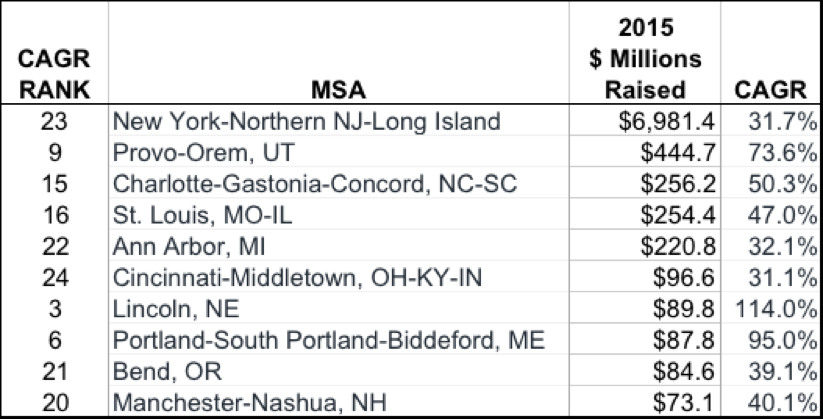April 22, 2016
Cracking into the Top 5 Fastest Growing Startup Cities
What factors determine the success rate of a population of venture-backed startups? And how is success measured? We can learn something by looking at the Top 5 fastest growing cities whose startups are collectively raising at least $200M.
Many people look at funding rounds (Series A, B, C, etc) as a measure of success, and it is to a degree, but that is more of a process metric. Success for investors is an exit, or liquidity event. In the eyes of economic development folks, it is often measured as the number of people employed.
A diverse set of outcomes and activities at the top and bottom of the proverbial funnel is important to long-term entrepreneur community growth. Ideally, we would see more than one significant company outcome (IPO) in combination with a healthy amount of new startup activity.
I wanted to test this hypothesis, so I began investigating the latest data from the National Venture Capital Association (“NVCA”) on venture funding in various regions around the country. Specifically, let’s look at the data that breaks out every Metropolitan Statistical Area (“MSA”) in the U.S. by five year Compounded Annual Growth Rate (“CAGR”).
I sorted the MSAs by the fastest growing (CAGR) and then by funding levels for the most recent year, 2015. The following chart shows the top 10 Fastest Growing and Biggest (most $ raised) regions.

Obviously, the New York region is an outlier in a number of ways. Provo, UT is doing amazingly well at $444.7M raised in 2015 and 73.6% CAGR. You can read more about the biggest regions, and specifically the Utah experiment, in this Inc. article last year by Ilan Mochari “Move Over, Silicon Valley: Utah Has Arrived”.
The next thing I noticed is that the top five regions by dollars raised are all above $220 million and then there is a big gap down to Cincinnati at $96.6 million. What’s going on here?
To understand this, I then looked at regions similar in size and geography. In this analysis I’ve highlighted the Ohio cities. Now what do you see?

- Total raised by startups in Ohio in 2015 was $262.7 million, similar in size to each of Ann Arbor, Boulder, Charlotte and St. Louis.
- Within Ohio, Cincinnati and Cleveland are similar in dollars raised, however Cleveland’s CAGR is -4.9% and Cincinnati is 31.1%.
- Within the Ohio cities, the average amount raised per company is $4.9 million, below the group average of $7.7 million. If you take the average dollars raised per company for the cities above $220 million, the result is $11.48 million, over double the average for Ohio.
- Pittsburgh raised twice as much as Cincinnati, but was only growing at a 3.9% rate, and average dollars raised per company was only $2.4 million.
The detailed data shows the growth in the Cincinnati region occurs in 2014 and 2015 of the CAGR calculation. It is the direct result of The Brandery, Cintrifuse, CincyTech, Queen City Angels and others working together as a community. The largest financing events driving the numbers were for Ahalogy, AssureX, Everything But The House and LISNR.
In Boulder, there were 9 companies that each raised $10 million or more in each of the last two years.
So what does it take to see a community of startups join the top group of over $200 million annually and sustain an annual growth rate above 30%?
From Verne Harnish’s book “Scaling Up”: There are 28 million companies in the U.S. and only 4% of them have $1 million in revenue or more. One-tenth of them, or 0.4%, make it to $10 million in revenue and only 17,000 reach $50 million or more in revenue. I wondered how these broad business metrics applied to a population of venture backed startups.
My suspicion is that it has to do with the number of companies raising larger Series B rounds. If you look at the data, that’s the gap. You can’t get there by simply funding more seed-stage startups. Companies need to make real progress in order to attract those larger rounds of capital. They need investors and advisors who can help them achieve that growth.
I’m assuming the existence of larger rounds of funding is supported by substantial growth in the company. How can we increase the percentage of startups that earn a Series B round? What are the key drivers?
It takes a strong network within and outside of the community to increase outcomes, including smart investors with direct experience growing companies from concept to tens of millions in revenue or more. These benchmarks will help us navigate our path to success and join the $220M+ cities. Of the 254 startups that are Cintrifuse members, we need to see 5 to 10 raising $10M+ rounds each year, or about 4%.
Once we know where we want to go, we need to be smart about how we navigate our way there. This data offers us some clues along our way. I’d like to find more data that would compare startup growth by region, and also look at exit data. If you have interest in helping me find the answers let me know!
Let’s not end up lost backstage like the members of Spinal Tap…”Rock and Roll! …. Hello Cleveland! … Hello Cleveland!”.
-
Jeffrey Shepard
-
Tim Schigel
-
-
Chris Rizik
-
Tim Schigel
-
-
Bob Gilbreath
-
Tim Schigel
-
-
Austin
-
Matt Lenahan
-
Tim Schigel
-
-
Ry Walker
-
Andy Nielsen
-
Timothy Holcomb
-
Tim Schigel
-
Tim R. Holcomb
-
-